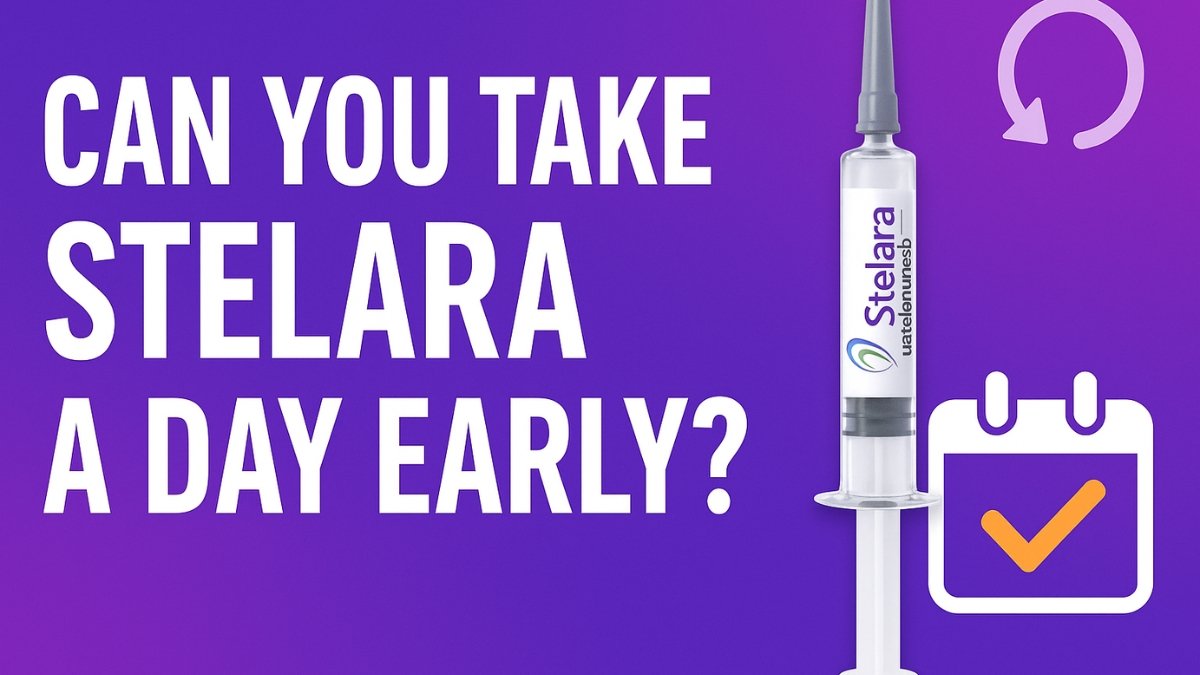Living with a chronic condition like psoriasis, psoriatic arthritis, Crohn’s disease, or ulcerative colitis often means adhering to a strict medication schedule. For those prescribed Stelara (ustekinumab), a common question arises: Can you take Stelara a day early? Missing a dose or needing to adjust your schedule due to travel, work, or other commitments can create uncertainty. This article dives deep into whether taking Stelara a day early is safe, effective, and advisable, offering expert-backed insights to help you make informed decisions. We’ll explore dosing guidelines, potential risks, and practical tips, ensuring you feel confident managing your treatment. Always consult your healthcare provider before making changes to your medication regimen.
Table of Contents
Understanding Stelara and Its Dosing Schedule
What Is Stelara?
Stelara is a biologic medication used to treat autoimmune conditions such as:
- Plaque psoriasis: Reduces skin inflammation and scaling.
- Psoriatic arthritis: Eases joint pain and swelling.
- Crohn’s disease: Manages inflammation in the digestive tract.
- Ulcerative colitis: Helps achieve and maintain remission.
It works by targeting specific proteins (IL-12 and IL-23) that contribute to inflammation, offering relief for moderate to severe symptoms. Administered via subcutaneous injection or intravenous infusion, Stelara requires a precise schedule to maintain its effectiveness.
Standard Stelara Dosing Schedule
Stelara’s dosing varies based on the condition being treated and the patient’s weight. Here’s a general overview:
| Condition | Initial Dose | Maintenance Dose |
|---|---|---|
| Psoriasis/Psoriatic Arthritis | 45 mg or 90 mg (based on weight) | Every 12 weeks after initial doses at week 0 and 4 |
| Crohn’s Disease | IV infusion (weight-based) | 90 mg every 8 weeks |
| Ulcerative Colitis | IV infusion (weight-based) | 90 mg every 8 weeks |
Key Point: Maintenance doses are typically spaced 8 or 12 weeks apart, making timing critical for consistent blood levels of the medication.
Can You Take Stelara a Day Early?
Is It Safe to Take Stelara a Day Early?
Taking Stelara a day early is generally considered safe for most patients, as a one-day deviation is unlikely to significantly disrupt the drug’s therapeutic levels. However, there are important considerations:
- Pharmacokinetics: Stelara has a long half-life (approximately 15–46 days), meaning it remains active in your system for weeks. A slight adjustment in timing is less likely to cause issues compared to medications with shorter half-lives.
- Consistency Matters: Regular intervals help maintain steady drug levels, optimizing symptom control. A one-day shift may not cause harm, but repeated early or late doses could impact efficacy.
- Individual Factors: Your condition, dosage, and overall health influence whether a day-early dose is safe. For example, patients with Crohn’s disease may need stricter adherence due to the condition’s complexity.
Case Study: Sarah, a 34-year-old with psoriasis, had to travel for a wedding and took her Stelara dose one day early. She consulted her dermatologist, who confirmed that a one-day shift was unlikely to affect her treatment, as her symptoms were stable. Sarah experienced no adverse effects and maintained her symptom-free status.
Potential Risks of Taking Stelara Early
While a one-day adjustment is often safe, there are risks to consider:
- Increased Side Effects: Administering Stelara early could slightly elevate the risk of side effects like injection site reactions or infections, especially if doses accumulate too closely.
- Reduced Effectiveness: Taking doses too frequently might not allow the body to fully process the previous dose, potentially reducing long-term efficacy.
- Immune System Impact: Stelara suppresses parts of the immune system, so frequent dosing adjustments could increase infection risk.
Expert Tip: Always track your dosing schedule using a calendar or app to avoid unintentional early or late doses. Apps like Medisafe or MyTherapy can send reminders.
Factors to Consider Before Taking Stelara a Day Early
Consult Your Healthcare Provider
Before taking Stelara a day early, contact your doctor or pharmacist. They can assess:
- Your current health status and disease activity.
- Any recent infections or immune system concerns.
- Interactions with other medications.
Example: John, a 45-year-old with Crohn’s disease, wanted to adjust his Stelara dose for a work trip. His gastroenterologist approved a one-day-early dose but advised monitoring for symptoms like fatigue or digestive issues.
Reasons for Adjusting Your Schedule
Common reasons patients consider taking Stelara early include:
- Travel: Time zone changes or flight schedules may necessitate a slight shift.
- Work or Personal Commitments: Busy schedules might require flexibility.
- Pharmacy or Supply Issues: Early administration may ensure access to medication.
Alternatives to Taking Stelara Early
If taking Stelara early isn’t ideal, consider:
- Taking It Late: A one-day delay is often just as safe as taking it early, depending on your doctor’s advice.
- Adjusting Plans: If possible, reschedule conflicting events to align with your dosing.
- Backup Plans: Keep extra doses (if prescribed) for emergencies, but never self-administer without guidance.
Visual Cue: Include an infographic showing a calendar with marked Stelara dosing days to help patients visualize their schedule.
How to Safely Manage Your Stelara Dosing
Best Practices for Stelara Administration
To ensure safe and effective use of Stelara:
- Follow Prescriber Instructions: Stick to the prescribed schedule unless advised otherwise.
- Store Properly: Keep Stelara refrigerated (36°F–46°F) and protect from light.
- Monitor Side Effects: Report symptoms like fever, rash, or injection site pain to your doctor.
- Use Reminders: Set alarms or use apps to track dosing dates.
Communicating with Your Healthcare Team
Open communication is key. When discussing dosing changes:
- Provide details about why you need to adjust your schedule.
- Ask about potential risks specific to your condition.
- Request guidance on monitoring symptoms after the adjustment.
Outbound Link: For more on Stelara’s dosing, visit Janssen’s official Stelara website for patient resources.
FAQs About Taking Stelara a Day Early
FAQ 1: What Happens If I Take Stelara a Day Early?
Taking Stelara a day early is unlikely to cause significant issues due to its long half-life, which allows stable blood levels even with minor timing changes. However, the impact depends on your condition and treatment plan. For psoriasis or psoriatic arthritis, a one-day shift may not disrupt symptom control, but for Crohn’s disease or ulcerative colitis, stricter adherence is often recommended due to the complexity of these conditions.
Potential Effects:
- Minimal Disruption: A one-day-early dose typically maintains therapeutic levels.
- Side Effects: Slight risk of increased injection site reactions or immune system effects.
- Long-Term Impact: Repeated early dosing could reduce effectiveness over time.
Actionable Advice: Always consult your doctor before adjusting your dose. Keep a log of your dosing dates to track any changes and monitor symptoms for a week after the adjustment. If you experience unusual symptoms like fatigue, fever, or worsening condition, contact your healthcare provider immediately.
Example: A patient with ulcerative colitis took Stelara a day early due to a family event. After consulting their doctor, they monitored for digestive changes and reported no issues, confirming the adjustment was safe in their case.
FAQ 2: Can Taking Stelara Early Affect Its Effectiveness?
Stelara’s effectiveness relies on maintaining consistent drug levels in your body. A one-day-early dose is unlikely to significantly impact efficacy, but frequent or significant deviations could. For example, taking doses too closely together might lead to higher-than-intended drug levels, potentially increasing side effects without improving symptom control.
Factors That Influence Effectiveness:
- Condition Severity: Severe cases may require stricter adherence.
- Dosing Frequency: Every-8-week schedules (e.g., Crohn’s) are less flexible than every-12-week schedules (e.g., psoriasis).
- Body Weight: Higher doses (90 mg) may have different tolerances for timing changes.
Actionable Advice: If you must take Stelara early, confirm with your doctor and avoid making it a habit. Use a journal to track symptoms and ensure the next dose aligns with the original schedule. For instance, if you take a dose on day 83 instead of 84, schedule the next dose 84 days later to maintain consistency.
Visual Cue: Suggest a table comparing normal vs. adjusted dosing schedules to clarify timing impacts.
FAQ 3: Are There Risks to Taking Stelara a Day Early?
While a one-day-early dose is generally safe, there are risks to consider:
- Increased Side Effects: Higher drug levels could increase risks like infections or injection site reactions.
- Immune Suppression: Stelara affects the immune system, so timing changes may heighten infection susceptibility.
- Insurance or Pharmacy Issues: Early dosing might complicate prescription refills if insurance requires strict adherence to schedules.
Real-World Example: A patient with psoriatic arthritis took Stelara early for a vacation. They experienced mild redness at the injection site but no other issues after confirming with their rheumatologist.
Actionable Advice: Discuss risks with your doctor, especially if you have a history of infections or are on other immunosuppressive drugs. Monitor for symptoms like fever or swelling for 1–2 weeks after the dose. Always follow proper injection techniques to minimize site reactions.
Outbound Link: Learn more about Stelara side effects at Mayo Clinic.
FAQ 4: How Can I Avoid Needing to Take Stelara Early?
Preventing the need to take Stelara a day early involves proactive planning:
- Set Reminders: Use apps like Medisafe to track dosing dates.
- Plan Around Events: Schedule travel or commitments around your dosing days.
- Communicate with Pharmacies: Ensure timely refills to avoid supply issues.
- Discuss Flexibility: Ask your doctor about acceptable windows for dosing adjustments (e.g., ±1 day).
Case Study: Maria, a 29-year-old with psoriasis, used a calendar app to align her Stelara doses with her work schedule. When a conflict arose, she consulted her doctor and rescheduled a meeting instead of adjusting her dose, maintaining her treatment plan.
Actionable Advice: Create a 12-month dosing calendar and share it with your healthcare team. If adjustments are unavoidable, confirm with your doctor and document the change to ensure future doses remain on track.
FAQ 5: Can I Take Stelara Early If I’m Traveling Across Time Zones?
Traveling across time zones can complicate medication schedules, but taking Stelara a day early is often feasible. Stelara’s long half-life provides flexibility, but time zone shifts may require planning to maintain consistency.
Tips for Traveling:
- Adjust Gradually: If crossing multiple time zones, take your dose at the closest equivalent time in the new zone.
- Consult Your Doctor: Confirm if a one-day shift is safe for your condition.
- Carry Documentation: Bring a letter from your doctor for airport security, as Stelara requires refrigeration.
Example: A patient traveling from New York to London (5-hour time difference) took Stelara a day early to align with their new schedule. Their doctor approved, and they stored the medication in a portable cooler during travel.
Actionable Advice: Pack Stelara in a cooler with ice packs and inform your doctor about your travel plans. Monitor symptoms post-dose to ensure stability.
Pros and Cons of Taking Stelara a Day Early
| Pros | Cons |
|---|---|
| Flexibility for travel or scheduling conflicts | Potential for increased side effects |
| Minimal impact due to long half-life | Risk of disrupting insurance/pharmacy refills |
| Maintains symptom control in most cases | Possible reduced effectiveness if repeated |
What’s New in 2025: Stelara and Biologic Management
In 2025, advancements in biologic therapy management include:
- Digital Health Tools: Apps like MyTherapy now integrate with telehealth platforms, allowing real-time dosing consultations.
- Biosimilars: Stelara biosimilars are entering the market, potentially affecting cost and access. Discuss with your doctor if switching is an option.
- Patient Support Programs: Janssen offers enhanced support via Janssen CarePath, including dosing reminders and financial assistance.
Visual Cue: Include a video from a trusted source like Janssen explaining Stelara’s administration process.
Conclusion
Taking Stelara a day early is generally safe for most patients, thanks to its long half-life, but it’s not a decision to make lightly. Consulting your healthcare provider is crucial to ensure safety and effectiveness, especially for conditions like Crohn’s disease or ulcerative colitis, where timing is critical. By understanding Stelara’s dosing, planning ahead, and using tools like reminders or apps, you can manage your treatment confidently. Always prioritize open communication with your doctor and monitor for side effects after any adjustment.






